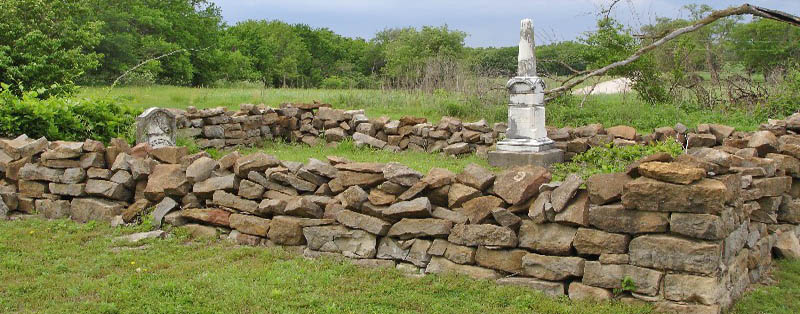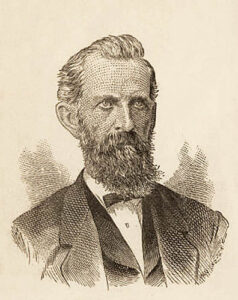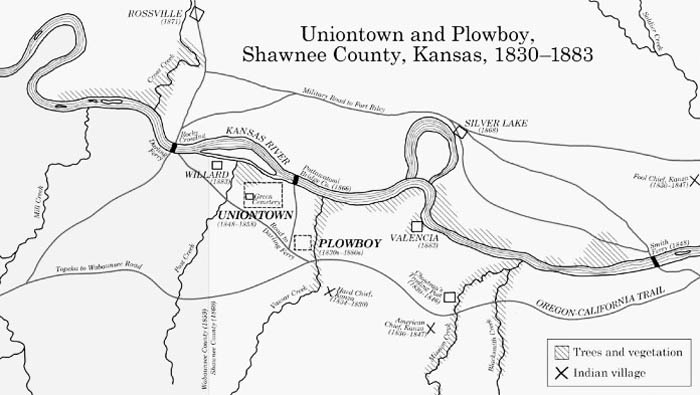
Uniontown, Kansas Cemetery courtesy Find-a-Grave.
Uniontown, Kansas, was a government trading post established in March 1848 for the Potawatomi Indians at a point nearly opposite the present town of Rossville in Shawnee County. It was located about a mile from the south bank of the Kansas River in Dover Township, a short distance from the Potawatomi reservation. At that time, Kansas was Indian Territory, land set aside for the tribes. Thomas N. Stinson came to the area in about 1843 and served as a blacksmith for the Potawatomi Agency on the Marais des Cygnes River.
Thomas N. Stinson ran the trading post and built the first house in 1848. At that time, extensive payments were made to the Indians in gold and silver, the amount in one instance reaching $130,000.
The location provided several promising advantages, including a high, level elevation, plenty of water, and a great trading business. Uniontown quickly became a last-chance stop for emigrants heading westward. The California/Oregon Trails crossed the river at this point. While some of Stinson’s customers were white, many others were Indians and people of mixed French and Indian descent. Foodstuffs, household goods, firearms, and many other items were available. Uniontown also offered travelers access to a doctor and blacksmith. Soon after, several more traders arrived and erected buildings, and in the following year, the place was called Uniontown. The government also maintained shops here and built a mill on Mill Creek. Several other traders, including Robert A. Kinzie, Ewing & Ewing, O. H. P. Polk, P. E. Sarpie, and T.D.S. McDonald, an agent for the Choteaus.
Uniontown became a place of importance and the “head center” of the Pottawatomi nation. It was the largest and most important trading point on the Kansas River for several years. As other settlers arrived, the hamlet grew to 60 buildings, 14 of which were stores, and soon had an estimated population of 300.
Unfortunately, Uniontown also beckoned card sharps, whisky vendors, gamblers, and thieves by the hundreds. The Missouri River towns sent forth a swarm of these grifters, and even St. Louis, Missouri, contributed its share. The presence of soldiers drove these men who preyed upon the Indians into the timber in the daytime, but they prowled around the town and camp at night, fleecing and robbing.
Soon, many emigrants were bypassing the famous Pappan Ferry crossing location at present-day Topeka, Kansas, to cross the river at Uniontown. The community offered the emigrants a much better crossing point because the current near Uniontown was slower and the water much more shallow than the Pappan Crossing.
In 1849, the prairies were invaded by gold seekers rushing to California and taking Uniontown in their route. Day after day, the trains of immigrants filed over the trails.
While at Uniontown, Thomas Stinson married 16-year-old Julia Beauchmie, a mixed-blood Shawnee Indian who had grown up at the Shawnee Indian Mission in present-day Kansas City. Julia’s father was a Potawatomi interpreter and preacher there. John C. Fremont, the famous explorer, was a friend of the Stinsons and was a frequent guest at their home throughout the 1840s and 1850s when he made several expeditions west. Thomas and Julia even named one of their daughters, Jessie Benton, after Frémont’s wife.
A cholera epidemic ravaged the community in the spring and summer of 1849 and 1850, changing the town’s future forever. Many of the settlers abandoned the village, and those who stayed died. The Potawatomi Indians were not immune from the epidemic. Hundreds died; 22 were buried in a mass grave in the Uniontown cemetery. A large cottonwood tree marks the mass grave. The town was then burned to ensure the cholera epidemic would not spread again.
This, however, was not the last chapter in the history of Uniontown. Traders returned, and the town was reestablished in 1851. Once again, it was a dominant trading point for Western travelers. It became a designated stop for almost every trail in northeast Kansas four years before the opening of Kansas Territory.
In 1853, Thomas moved his business east, founding the town of Tecumseh, Kansas. There, he and Julia made their home on land she had acquired as part of the Shawnee settlement. Among his other business ventures, Thomas briefly ran a trading post on the Shunganunga Creek and operated a ferry across the Kansas River. Later, he worked with an Indian trade and mercantile company, Simpson & Hunter of Westport, Missouri.
When General John C. Fremont visited on October 25, 1853, and reported in his diary:
“Went to Uniontown and nooned. This is a street of log cabins. Nothing to be had here… lots of John Barleycorn [whiskey] which the men about were consuming.”
At the time, there was a government regulation against providing alcohol to Indians, to which the army looked the other way. Also, land speculation on town lots was on land that belonged to the Potawatomi in trust as part of their reservation.
Before Kansas Territory opened in 1854, only American Indians, military personnel, government traders, and missionaries were allowed in the region. When the territory officially opened, it was the beginning of the end for Uniontown.
New towns sprang up nearby in the Kansas River Valley, including Topeka and Tecumseh. While at its peak, Uniontown was the only community for miles, but now, competition for trade was stiff. Topeka attracted more settlers and businesses, and soon, the traders of Uniontown abandoned their homes to make their fortunes elsewhere. The Pottawatomi agency was moved to St. Marys in Pottawatomie County. In 1855, the trading post was broken up. However, a post office opened on February 20, 1856. But it was short-lived, closing about six months later on August 28, 1856.
Before long, a farm was cultivated on the old townsite.
In 2010, the National Park Service recognized Uniontown on its National Register of Historic Places for its significance in Potawatomi Indian, U.S., and Shawnee County, Kansas history.
Today, all that remains is a tiny country cemetery with a few graves surrounded by a stone wall. Nearby is an old stone house, a testament to “long ago.”
The old townsite is near the present town of Willard, Kansas
©Kathy Alexander/Legends of Kansas, updated October 2023.
Also See:
Sources:
Kansas History: A Journal of the Central Plains 37 (Winter 2014–2015): 210–225
Kansas State Historical Society
Kansas State Historical Society – 2
National Register Nomination
Remembering Uniontown
Washburn University



